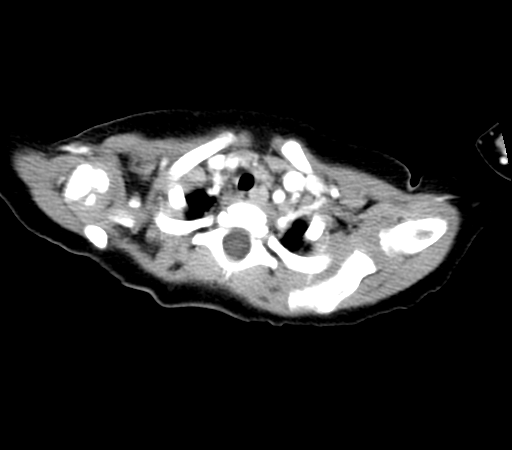Wilms' tumor CT
Editor-In-Chief: C. Michael Gibson, M.S., M.D. [1]
|
Wilms' tumor Microchapters |
|
Diagnosis |
|---|
|
Treatment |
|
Case Studies |
|
Wilms' tumor CT On the Web |
|
American Roentgen Ray Society Images of Wilms' tumor CT |
Overview
CT scan may be helpful in the diagnosis of wilms' tumor.
CT
- Abdominal CT scan may be helpful in the diagnosis of wilms tumor.
- Findings on CT scan suggestive of/diagnostic of wilms tumor include:
- Contrast-enhanced CT or magnetic resonance imaging (MRI) is recommended to further evaluate the nature and extent of the mass. CT or MRI also may detect small lesions of tumor or nephrogenic rests in the opposite kidney, which were not detected by ultrasonography. The Children’s Oncology Group (COG) evaluated the diagnostic performance of CT and MRI for local staging of pediatric renal tumors and found that they have similar ability to detect lymph node metastasis and capsular penetration [56]. MRI detected more contralateral synchronous lesions; however, these were rare. The investigators concluded either modality can be used for initial locoregional staging of pediatric renal tumors based on institutional expertise, need for anesthesia, risks of radiation exposure, and cost concerns. At our institution, we typically use CT at the time of initial diagnosis; MRI or CT may be used for follow up imaging depending on the patient’s specific circumstances. In a separate study, COG investigated the role of preoperative CT scans in detecting tumor rupture and found that ascites beyond the cul-de-sac was the best indicator of rupture; however, the sensitivity of CT to detect tumor rupture was poor (54 to 70 percent) [57].
- Wilms tumours are heterogeneous soft-tissue density masses with frequent areas of calcification (~10%) and fat-density regions.
- Enhancement is also patchy, and allows for better delineation of the relationship between the mass and kidney.
- 20% of cases have lung metastases at time of diagnosis.[1]
- CT scan shows a renal mass which often shows one or more of the following:
- areas of hemorrhage
- invasion of surrounding organs
- thrombus in or occlusion of the renal vein and/or the inferior vena cava
- abdominal lymph nodes and contralateral involvement
- A preoperative CT scan helps to better estimate tumor size and volume and to plan surgical management more successfully.
- It is a useful tool to determine stage based on tumor size and structures involved.[2][3]

References
- ↑ Wilms tumour. Dr Tim Luijkx and Dr Frank Gaillard et al. Radiopaedia.org 2015.http://radiopaedia.org/articles/wilms-tumour
- ↑ Pshak TJ, Cho DS, Hayes KL, Vemulakonda VM. Correlation between CT-estimated tumor volume, pathologic tumor volume, and final pathologic specimen weight in children with Wilms' tumor. J Pediatr Urol. 2014 Feb;10(1):148-54. doi: 10.1016/j.jpurol.2013.08.001. Epub 2013 Sep 12.
- ↑ McDonald K, Duffy P, Chowdhury T, McHugh K. Added value of abdominal cross-sectional imaging (CT or MRI) in staging of Wilms' tumours. Clin Radiol. 2013 Jan;68(1):16-20. doi: 10.1016/j.crad.2012.05.006. Epub 2012 Aug 11.